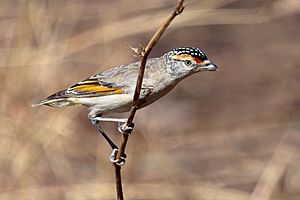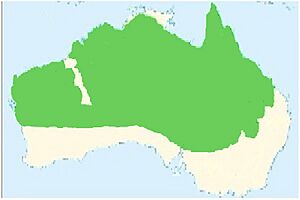Red-browed pardalote facts for kids
The red-browed pardalote (Pardalotus rubricatus) is a small, colorful bird. It eats insects and lives only in Australia. These birds are specialists at finding food in eucalypt trees. They pick insects and other tiny creatures right off the leaves.
The name "rubricatus" comes from Latin. It means "red-ochred," which describes their orange-red eyebrow. People also call them red-browed diamondbird or bellbird.
Quick facts for kids Red-browed pardalote |
|
|---|---|
 |
|
| Conservation status | |
| Scientific classification | |
| Genus: |
Pardalotus
|
| Species: |
rubricatus
|
Contents
About the Red-browed Pardalote
Red-browed pardalotes belong to a group of birds called Passeriformes. They are part of the Pardalotidae family. There are four known species in this family:
- red-browed pardalote (Pardalotus rubricatus)
- spotted pardalote (Pardalotus punctatus)
- forty-spotted pardalote (Pardalotus quadragintus)
- striated pardalote (Pardalotus striatus)
Scientists used to group pardalotes with other small birds called acanthizid warblers. But new studies show that pardalotes are more closely related to honeyeaters. Because of this, they are now in their own family, Pardalotidae.
Different Kinds of Red-browed Pardalotes
In 1913, a scientist named Matthews found a special type of red-browed pardalote. It is called Pardalotus yorki. These birds live in Far North Queensland, near the Gulf of Carpentaria.
Pardalotus yorki looks a bit different from other red-browed pardalotes. They have slightly different colors and body shapes.
What Do They Look Like?
Adult red-browed pardalotes are fairly large for a pardalote. They are about 10.5 centimeters (4 inches) long. Their wings can spread out to about 6 to 6.6 centimeters (2.3 to 2.6 inches). Males and females weigh almost the same, around 10.8 to 10.9 grams.
The yorki subspecies is a bit smaller. They are 10 to 12 centimeters long and weigh about 9.3 grams. Their wingspan is also a bit shorter, from 5.8 to 6.2 centimeters.
Colors and Markings
Red-browed pardalotes do not change their colors with the seasons. Males and females look very similar. They have a light-colored eye and a black head with clear white spots.
They have a yellow stripe above their eye, called a supercilium. Their eyebrow is red to orange-red. They also have a yellow patch on their chest and yellow parts on their wings. Young birds are usually paler than adults. Their eyes are darker, and their colors are not as bright.
The yorki subspecies is usually brighter in color. They have straw-brown or yellow eyes. Their black head has fine spots. They have a bright yellow chest patch and a yellow rump. They also have an orange part on their wings.
Their Call
The red-browed pardalote has a special call. It is a song with five or six notes. The first note is longer and lower. The other notes get higher in pitch and faster.
Males often call while they are feeding. They sing from a hidden spot in the trees. This helps them tell other birds where their territory is. Some people say their call sounds like a rosella bird.
Where Do They Live?
The red-browed pardalote lives in many parts of Australia. You can find them in the north, central, and southern parts of Western Australia. They also live in northeast South Australia and southwest New South Wales. They are found in large deserts like the Great Sandy and Great Victoria Desert.
These birds live in many different places. This includes woodlands, shrublands, and dry or semi-dry areas. They especially like eucalypt woodlands near rivers and water. They also like tall eucalypt shrublands.
In the desert, they look for food in tall trees like bloodwoods. They can also be found in other types of woodlands. This includes areas with acacia trees, spinifex plains, and grasslands. They might also live in sand dunes, rocky areas, and valleys.
What Do They Do?
Red-browed pardalotes usually stay in one place. They keep the same feeding areas all year round. You might see them alone, in pairs, or in small groups of up to six birds.
They spend most of their time in eucalypt trees. They use their special "scoop-shaped" beak to pick up insects. They also eat "lerps," which are sugary coverings made by tiny insects called psyllids. Lerps are a very important food source for them.
They also eat many other small creatures. This includes beetles, flies, mosquitoes, leafhoppers, and ants.
Red-browed Pardalote Life Cycle
Red-browed pardalotes breed between July and December. In dry areas, they might breed after it rains. Pairs stay together and protect their breeding territory.
Both the male and female dig a tunnel. This tunnel can be from 6 to 122 centimeters (2.4 to 48 inches) long. At the end of the tunnel, they dig a nesting room. This room is about 10 to 12.7 centimeters (4 to 5 inches) deep. They can dig these tunnels in sandy banks, gullies, or piles of sand.
Sometimes, they use burrows dug by other animals. These can be burrows from kangaroo rats, hopping mice (Notomys), or bilbies (Macrotis lagotis). They might also nest in hollow parts of trees. One bird was even found nesting inside an iron pipe!
They build a cup-shaped nest inside the chamber. They use strips of bark, horsehair, and fine grass to build it. They lay up to four white, oval eggs. Both parents sit on the eggs to keep them warm. After the chicks hatch, both adults feed them.
How Are Their Numbers Doing?
The International Union for the Conservation of Nature (IUCN) says the red-browed pardalote is a species of least concern. This means they are not currently in danger of disappearing. Even though we don't know the exact number of these birds, they are common. Their population seems to be stable.
See also
 In Spanish: Pardalote cejirrojo para niños
In Spanish: Pardalote cejirrojo para niños



